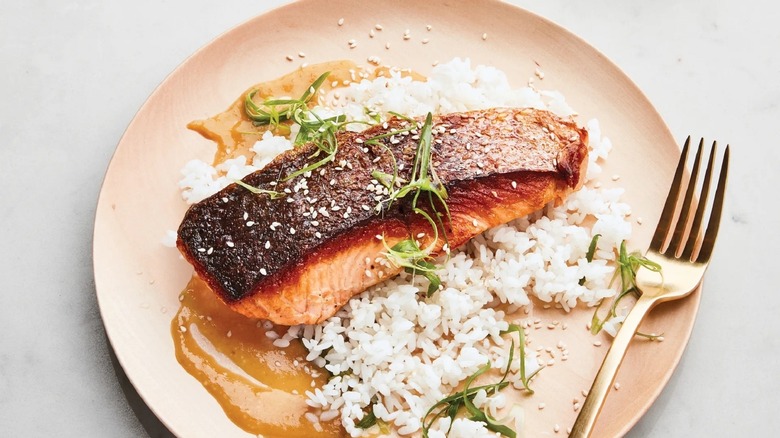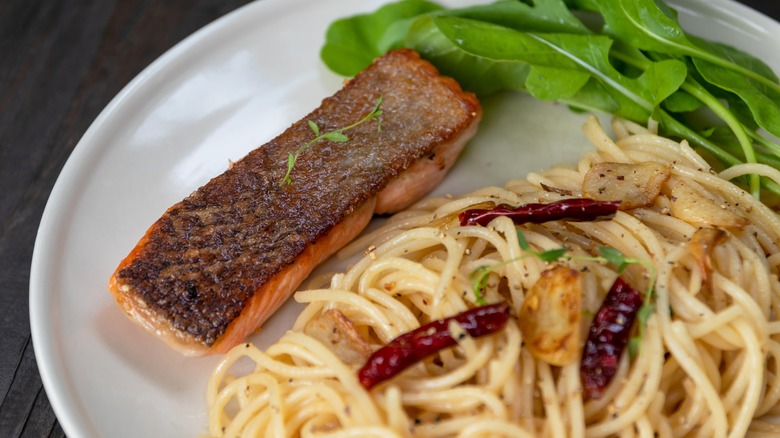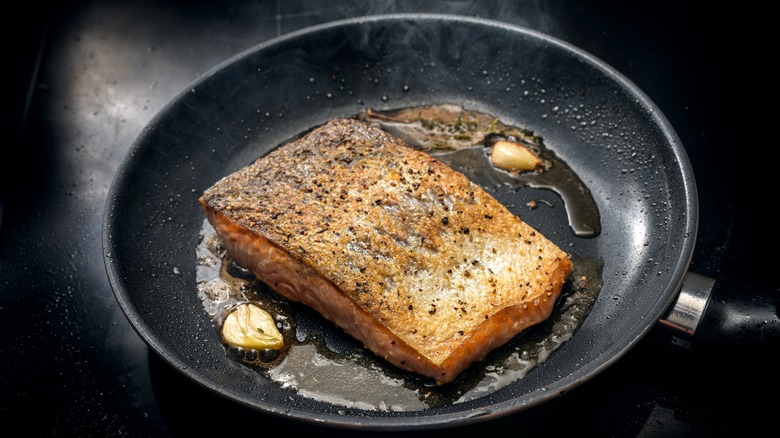Is Salmon Skin Actually Edible?
Salmon is near and dear to my heart, having grown up with my dad searing it skin-on, and the skin was always the tastiest part. However, later in life, my boyfriend told me to always take the skin off when cooking, arguing, "You can't eat that! You'll get sick." So, which is it?
The most straightforward answer is yes, you can eat the salmon skin. However, be warned if you've never tried it — salmon skin has a stronger fishy taste, so if seafood isn't your thing, it might not be for you (personally, I think it's delicious!). That said, there have been concerns about possible chemical contamination in salmon, particularly from polychlorinated biphenyls (PCBs), synthetic chemicals once used in products like electrical equipment and paint. Though banned in the 1970s, PCBs still leak into the environment from hazardous waste sites and old equipment and can end up in fish. PCBs have been linked to health risks such as cancer and issues with the immune and reproductive systems. These chemicals are most concentrated in the fatty parts of the fish, like the skin and the layer right beneath it.
Experts agree that farmed and wild salmon are generally safe to eat, but taking precautions can reduce your exposure to any potential contaminants. If you're concerned about PCBs, avoiding the skin and trimming the fat can reduce the risk of ingesting these chemicals — though you'll miss out on that crispy skin goodness.
The health benefits of salmon skin
Before you start peeling away the tastiest part of the salmon because of concerns about PCBs, it's worth knowing that salmon skin offers some impressive health benefits. It contains the highest concentration of omega-3 fatty acids in the whole fish, which have been shown to reduce the risk of heart attacks. Omega-3s also play a crucial role in brain health, supporting cognitive function and reducing inflammation in the body.
In addition to omega-3s, salmon skin is rich in nutrients like vitamin D and selenium, which help regulate mood and metabolism, promoting overall wellness. Salmon skin nourishes your skin as well, supplying niacin to keep it moisturized and glowing.
When choosing salmon, opt for wild-caught if you can, meaning it was caught in the open ocean rather than raised on a farm. Wild salmon has more anti-inflammatory omega-3s and fewer chemical contaminants. For the best quality, choose wild-caught salmon from the Pacific Ocean, as fish from the Atlantic tend to have slightly higher levels of contaminants.
How to cook salmon skin
When searing or grilling salmon with the skin on, the ultimate goal is achieving that deliciously crispy skin that adds a potato-chip-like crunch to your meal. Although you can technically cook salmon in the microwave, it's definitely not the way to achieve crispy skin. Start by making sure the fish is descaled — those scales can taste like plastic, and no one wants that in their dish. Often, the person at the seafood counter will descale the fish, but they may miss spots, so double-check.
There's no need to rinse the salmon; rinsing can spread contamination. Instead, just pat the skin completely dry with a paper towel. Season the skin right before placing it in the pan. Adding salt too early draws moisture out, which can make the skin soggy. Avoid using black pepper or powdered spices like garlic or onion on the skin, as they tend to burn.
Preheat your pan and add enough high smoke point oil, like ghee or avocado oil, to coat the bottom. The oil should shimmer but not smoke aggressively. Cook the salmon skin-side down for about 90% of the time. This allows the skin to get crispy while gently cooking the flesh. Once it's almost done, flip the fish for a brief sear on the other side to finish cooking. When plating, keep the skin side up so it doesn't get soggy. Plus, you'll get to show off that beautifully golden, crispy skin!


